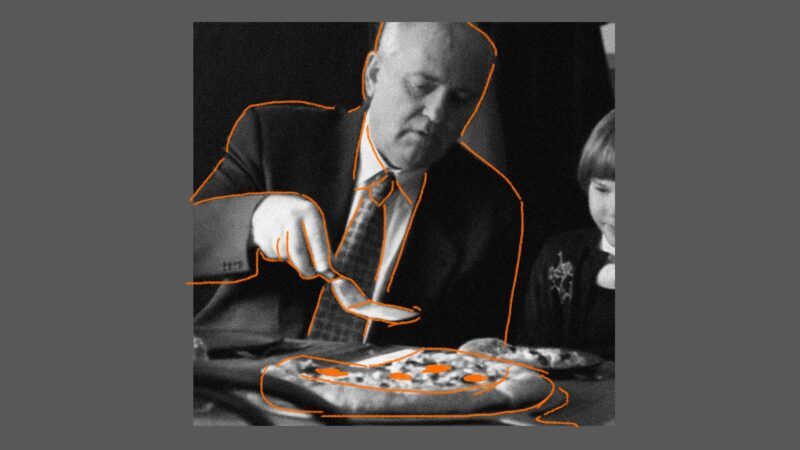That Time Mikhail Gorbachev Appeared in a Pizza Hut Commercial
There may not be a more striking metaphor for capitalism's victory over the Soviet Union than a 60-second Pizza Hut ad that originally aired more than 20 years ago.

There may not be a more striking metaphor for capitalism's victory over the Soviet Union than a 60-second Pizza Hut ad that originally aired more than 20 years ago but continues to get passed around the internet as a fascinating tidbit of 1990s political commentary.
The ad, filmed in November 1997, features former (and final) Soviet president Mikhail Gorbachev visiting a Pizza Hut ostensibly located in the middle of Moscow. Gorbachev does not speak a single line of dialogue in the ad—nor does he take a bite of pizza, as he reportedly agreed to do the spot with the condition that he would not have to eat on-camera—but he is undeniably the star, as other patrons in the restaurant notice their fallen comrade and debate his significance to Russia, freedom, and pizza.
It's not hard to see the ad as a notable bit of now-quaint 1990s commentary on the supposed "end of history" and American hegemony—and perhaps an overly optimistic view of how Russia would evolve in the post-Soviet era. If nothing else, it says, capitalism provides cheap pizza for the masses—and that's far more than communism could ever do.
But there are layers of meaning that extend well beyond the obvious political commentary. Gorbachev agreed to appear in Pizza Hut's ad, according to The New York Times, because he was hard-up for cash six years after stepping down as the leader of a global superpower. He was paid an undisclosed amount that was rumored to be near $1 million, according to the Times' contemporaneous report.
"I thought that it is a people's matter—food," he told the paper.
According to University of Massachusetts political science professor Paul Musgrave's detailed recap of how the ad came to be, filming took place on Thanksgiving—fitting, since the holiday is a quintessentially American celebration of food and the surpluses made possible by capitalism. Musgrave calls the final product "a beautiful short film and a very weird advertisement."
It is definitely both of those things, but the most interesting and significant part of the ad has little to do with Gorbachev or pizza. During the Soviet era, Russians were not likely to gather over a warm meal and freely discuss politics. As Reason's Liz Wolfe details in the December issue of the magazine, much of the social structure of Soviet life was designed to prevent exactly that sort of thing: "Prior to the revolution, families could speak their minds comfortably while preparing and sharing a meal. But Stalin felt privacy created far too much space for dissent to take root and multiply. His solution was to abolish familial intimacy as much as possible. In his new kommunalkas, you would never be far from the watchful eye of a compatriot who might snitch."
Even after Gorbachev liberalized parts of the economy, restaurant culture took a long time to bounce back from how it had atrophied under restrictive Soviet rule. Yes, the demise of the Soviet system allowed Russians to finally enjoy Pizza Hut, but also everything else that comes with enjoying a nice meal prepared in a restaurant.


Show Comments (118)